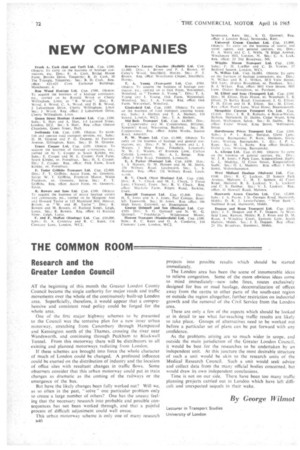THE COMMON ROOM
Page 74

If you've noticed an error in this article please click here to report it so we can fix it.
Research and the Greater London Council
AT the beginning of this month the Greater London County Council became the single authority for major roads and traffic movements over the whole of the continuously built-up London area. Superficially, therefore, it would appear that a comprehensive and consistent road policy could be forged for the whole area.
One of the first major highway schemes to be presented to the Council was the tentative plan for a new inner urban motorway, stretching from Canonbury through Hampstead and Kensington north of the Thames, crossing the river near Wandsworth, and continuing through Peckham to Black wall Tunnel. From this motorway there will be distributors to all existing and planned motorways radiating from London.
If these schemes are brought into force the whole character of much of London could be changed. A profound influence could be exerted on the distribution of industry and the location of office sites with resultant changes in traffic flows. Some observers consider that this urban motorway could put in train changes as dramatic as the coming of the railways or the emergence of the bus.
But have the likely changes been fully worked out? Will we, as so often in the past, " solve " one particular problem only to create a large number of others? One has the uneasy feeling that the necessary research into probable and possible consequences has not been worked through, and that a painful process of difficult adjustment could well ensue.
This urban Motorway scheme is only one of many research ri40 projects into possible results which should be started immediately.
The London area has been the scene of innumerable ideas to relieve congestion. Some of the more obvious ideas come to mind immediately-new tube lines, routes exclusively designed for bus or road haulage, decentralization of offices away from the centre to other parts of the south-east region or outside the region altogether, further restriction on industrial growth and the removal of the Civil Service from the London area.
These are only a few of the aspects which should be looked at in detail to see what far-reaching traffic results are likely to take place. Groups of alternatives need to be worked out before a particular set of plans can be put forward with any confidence.
As the problems arising are so much wider in scope. and outside the main jurisdiction of the Greater London Council. it would be best for the researches to be undertaken by an independent unit. At this juncture the most desirable structure of such a unit would be akin to the research units of the Medical Research Council. Such a unit would seek advice and collect data from the many official bodies concerned, but would draw its own independent conclusions.
Time is not on our side. There have been too many traffic planning projects carried out in London which have left difficult and unexpected sequels in their wake.
By George Wilmot
Lecturer in Transport Studies University of London




















































































































